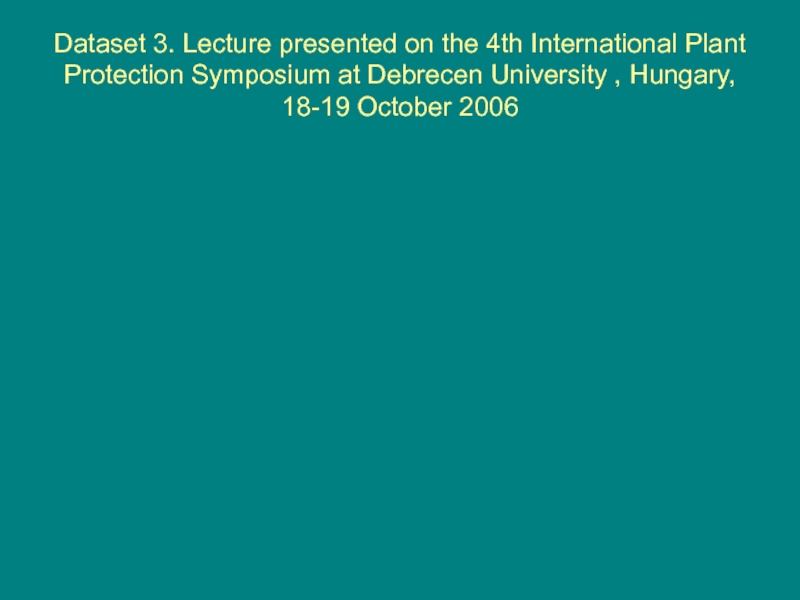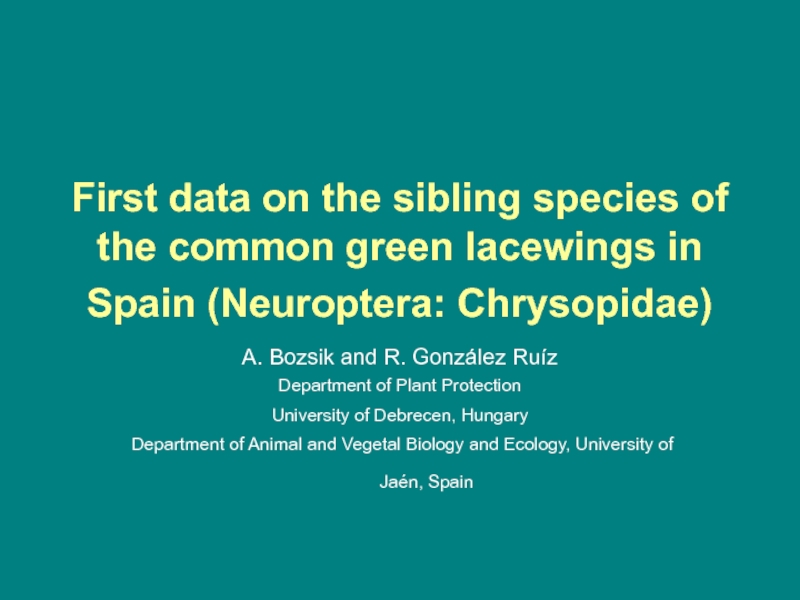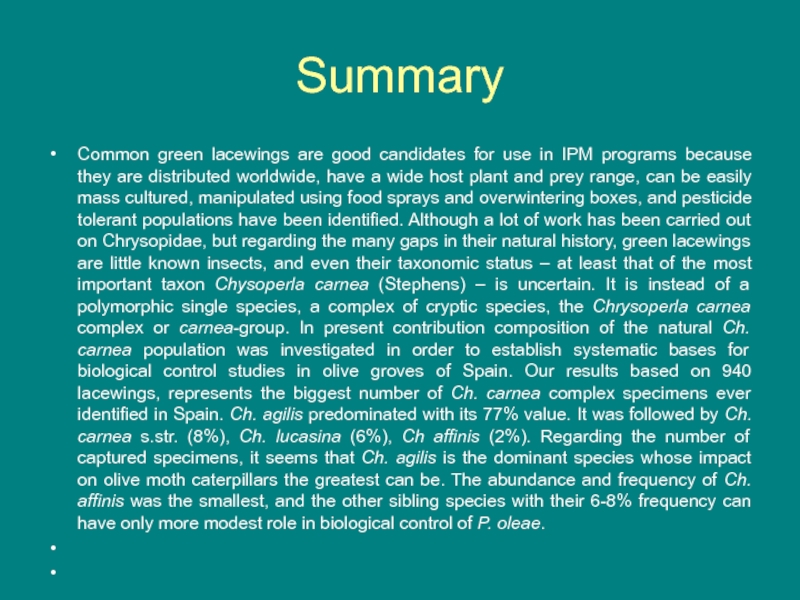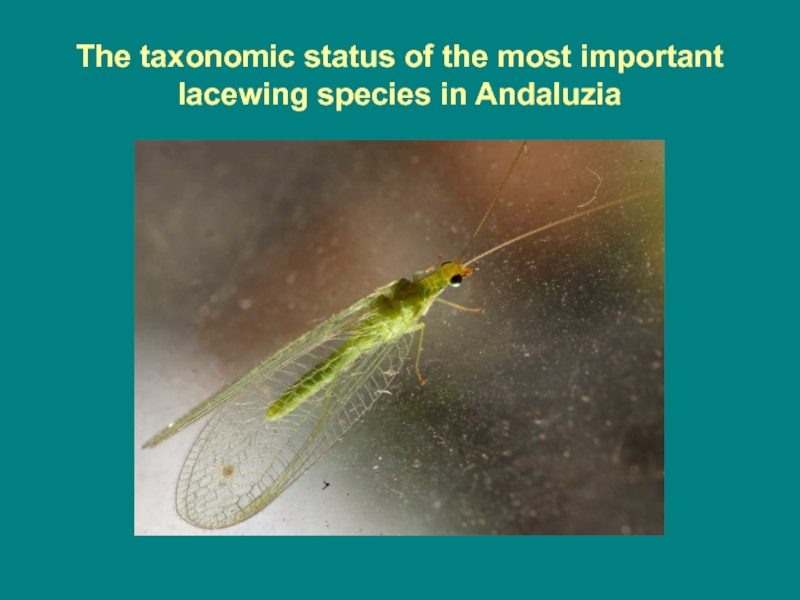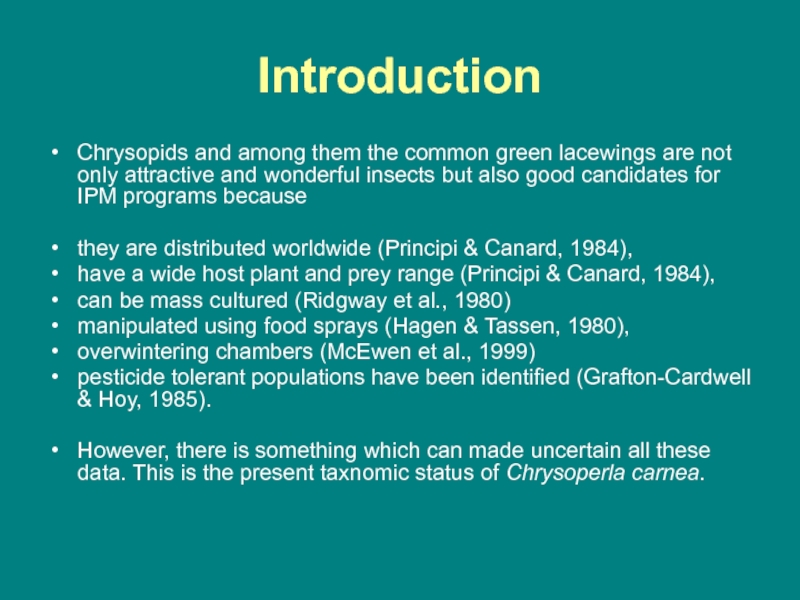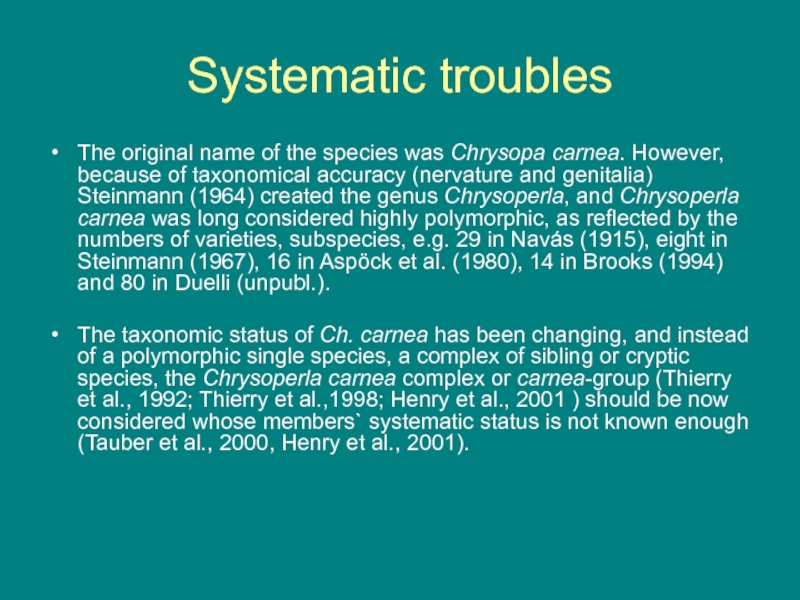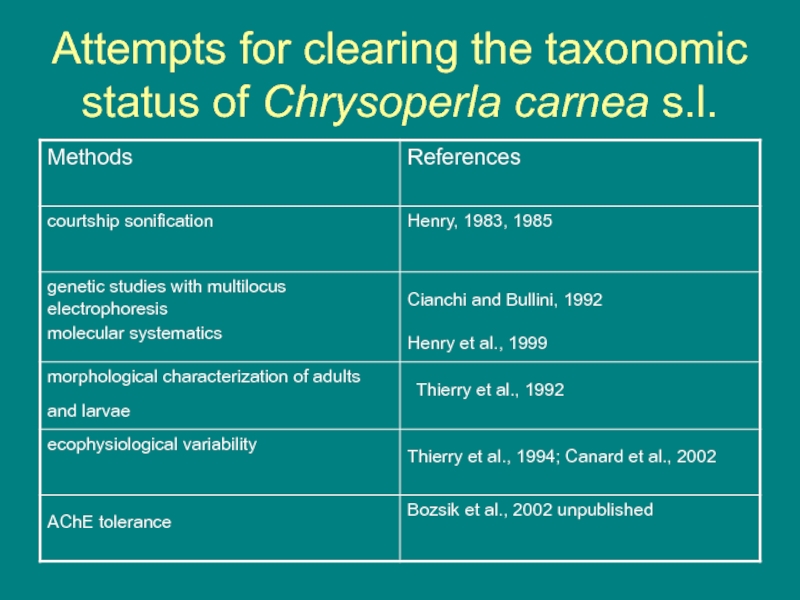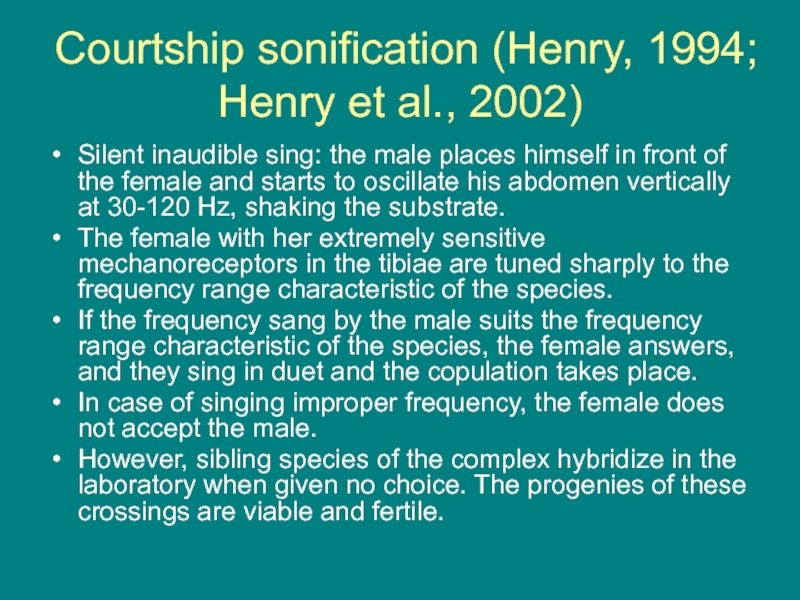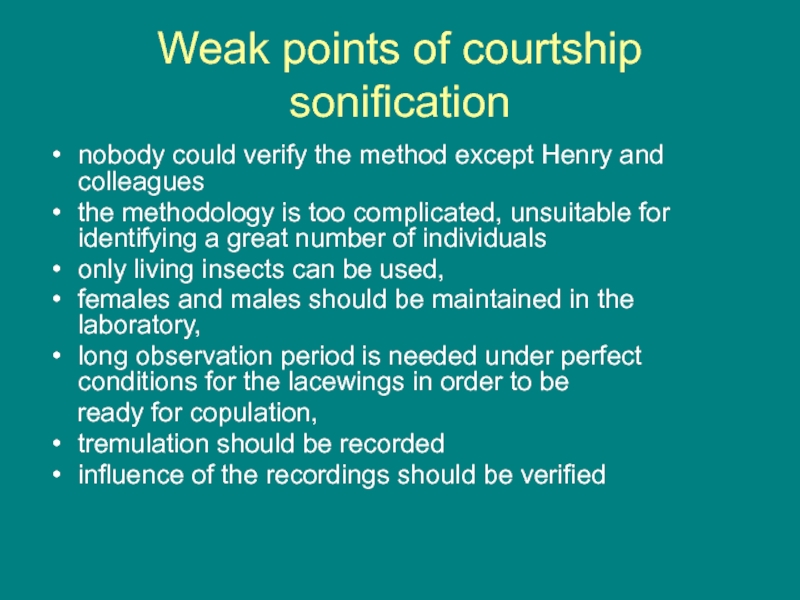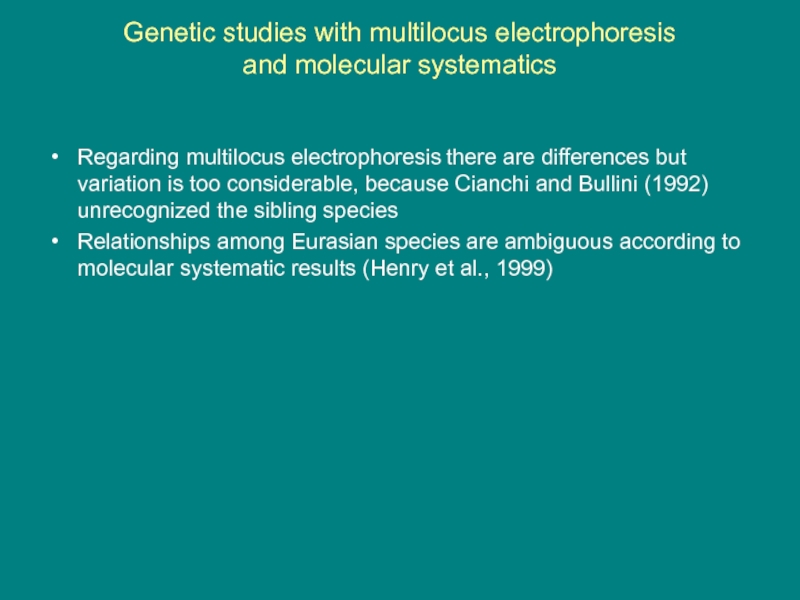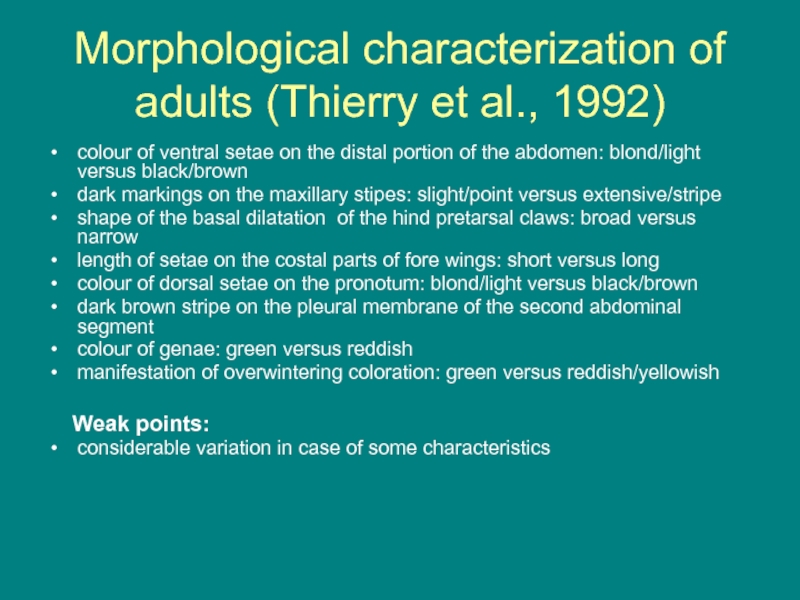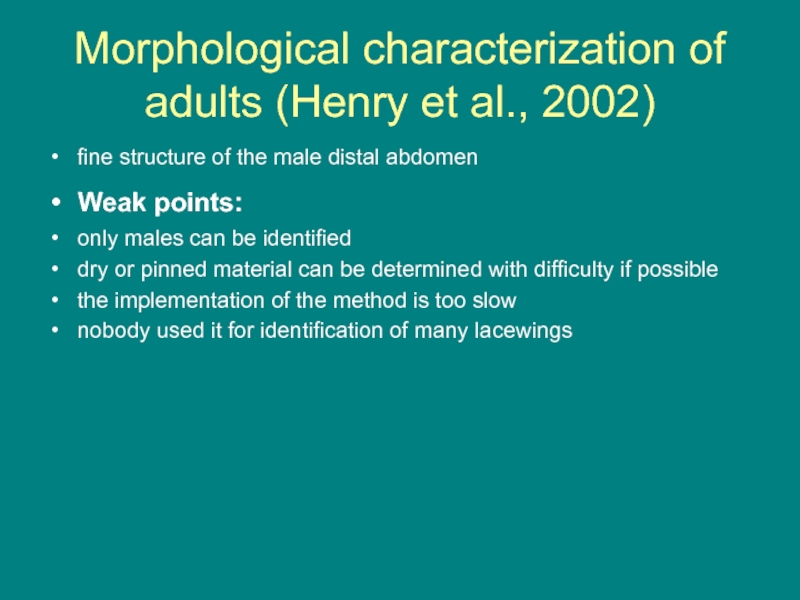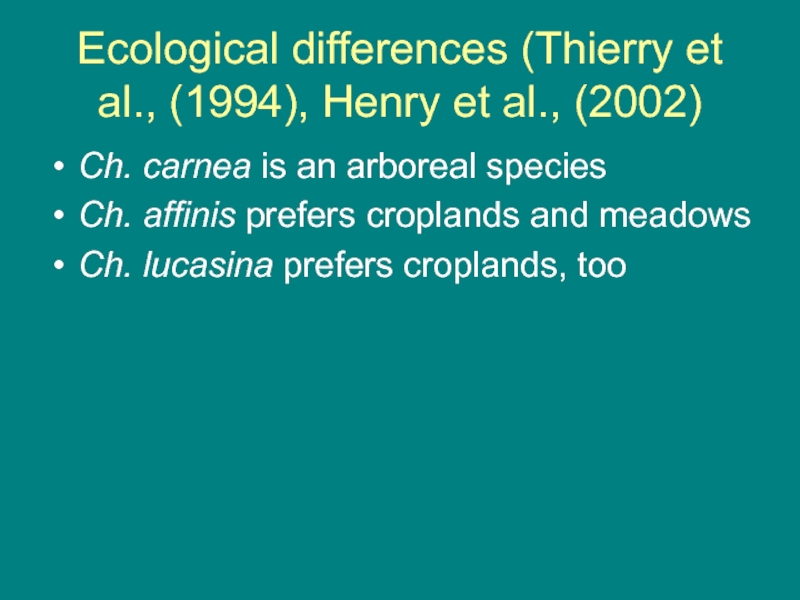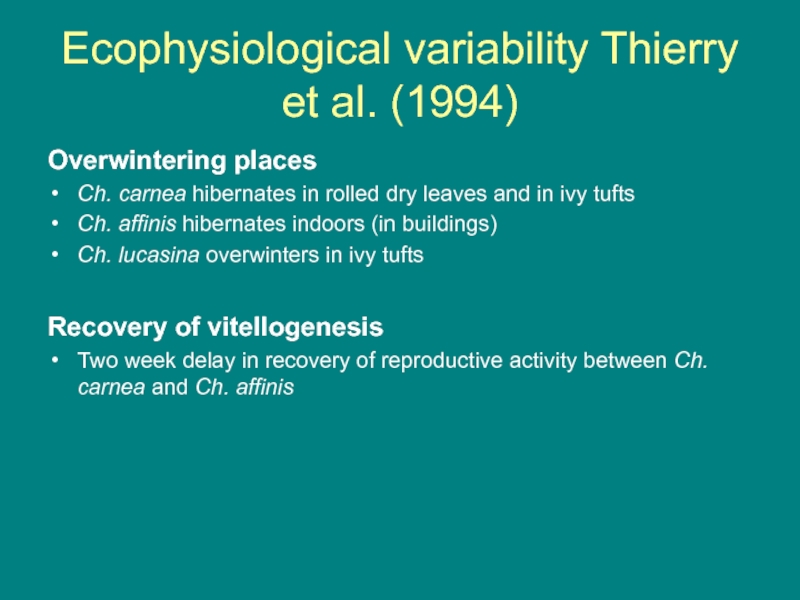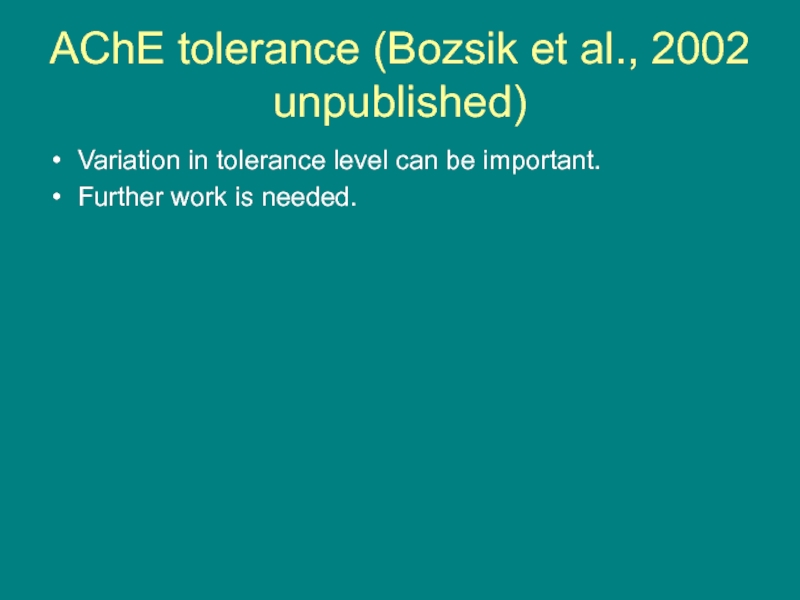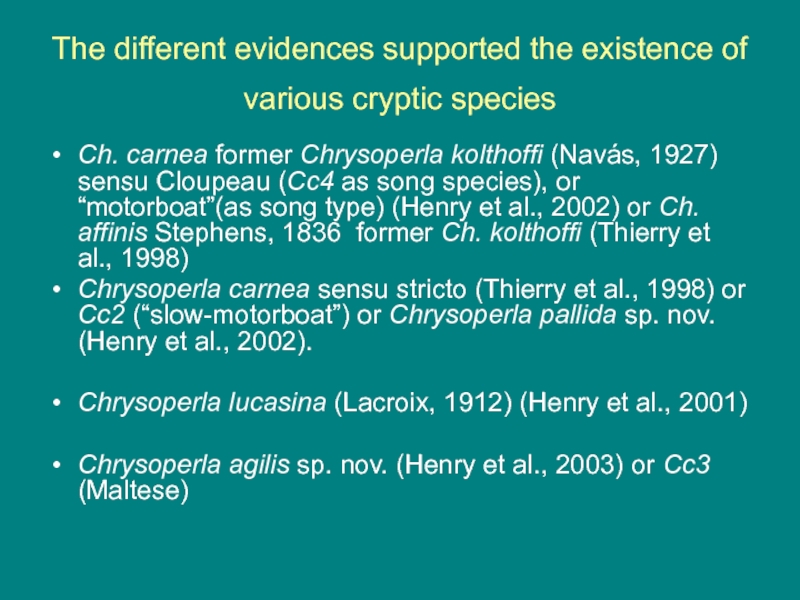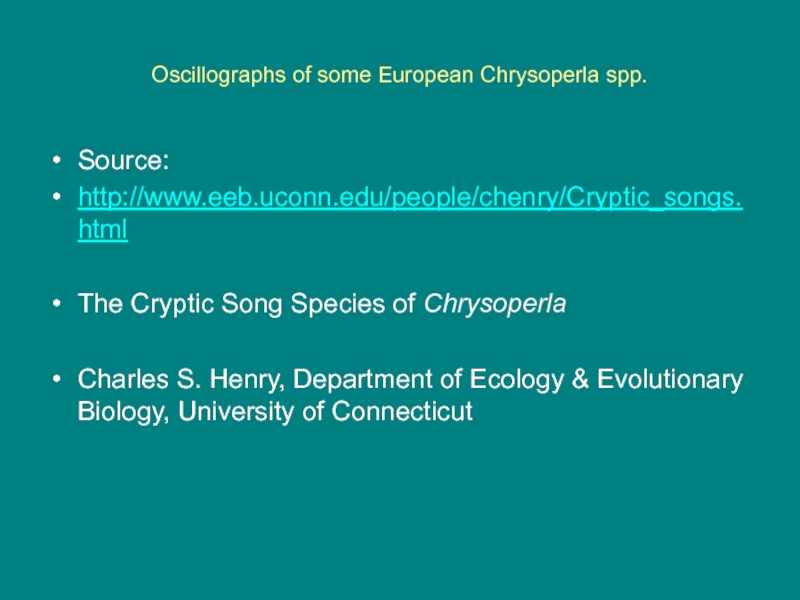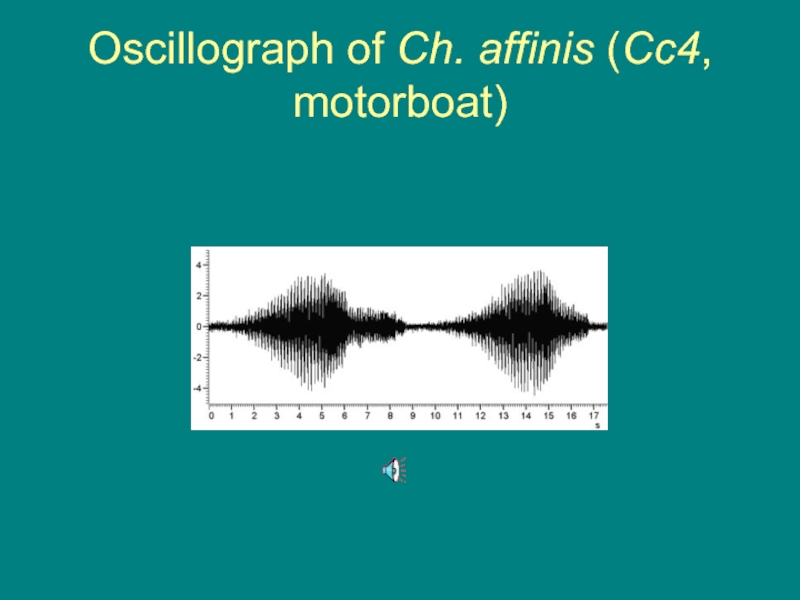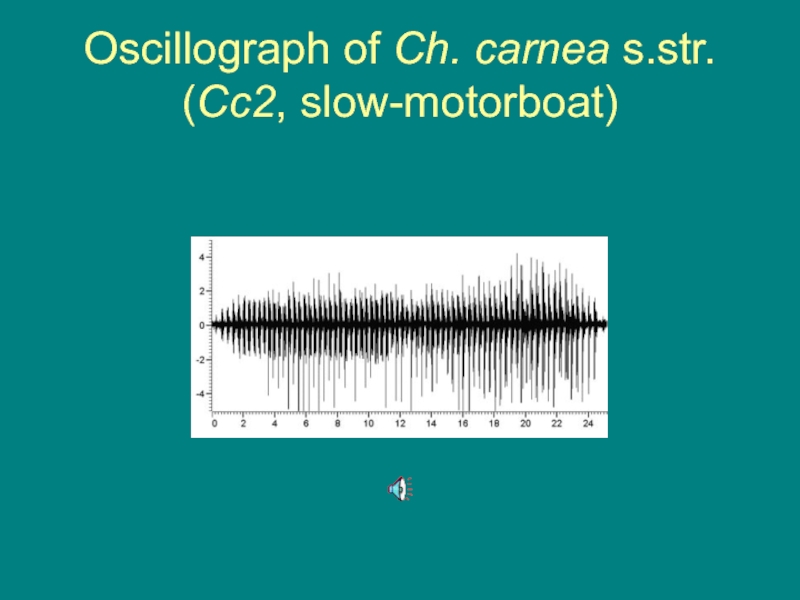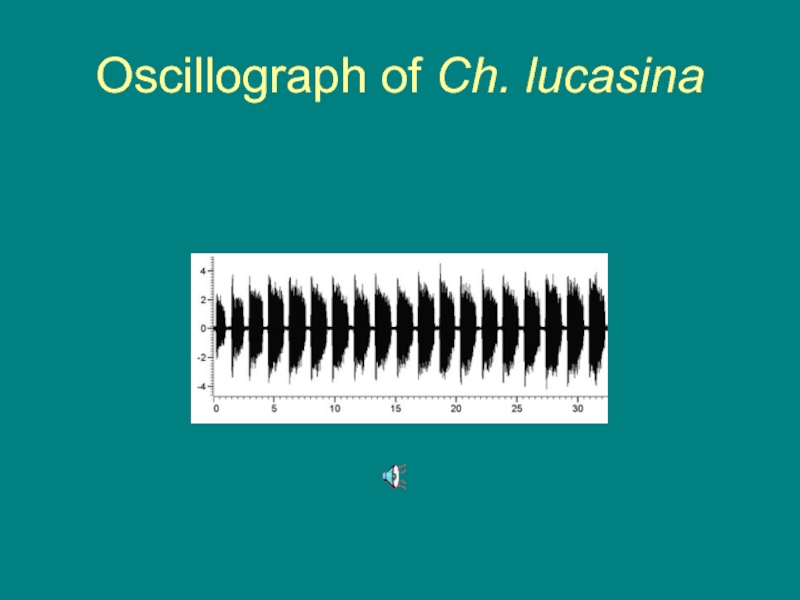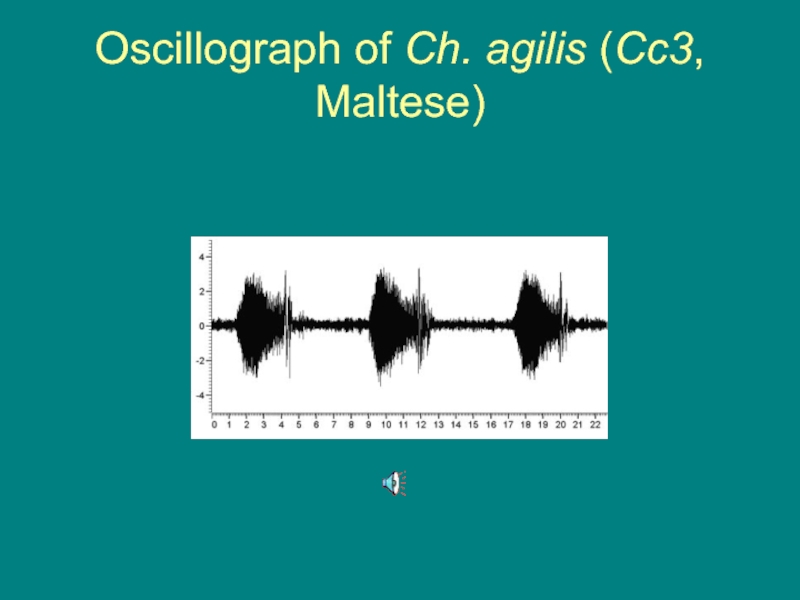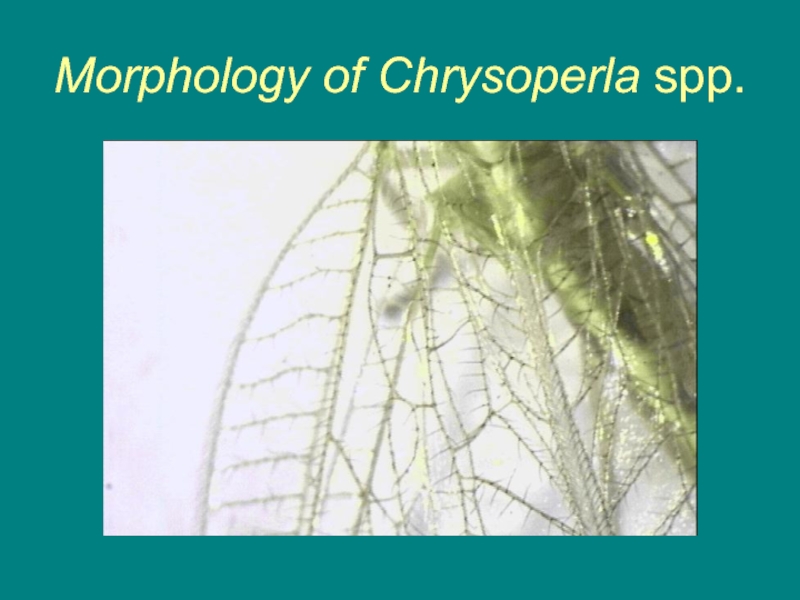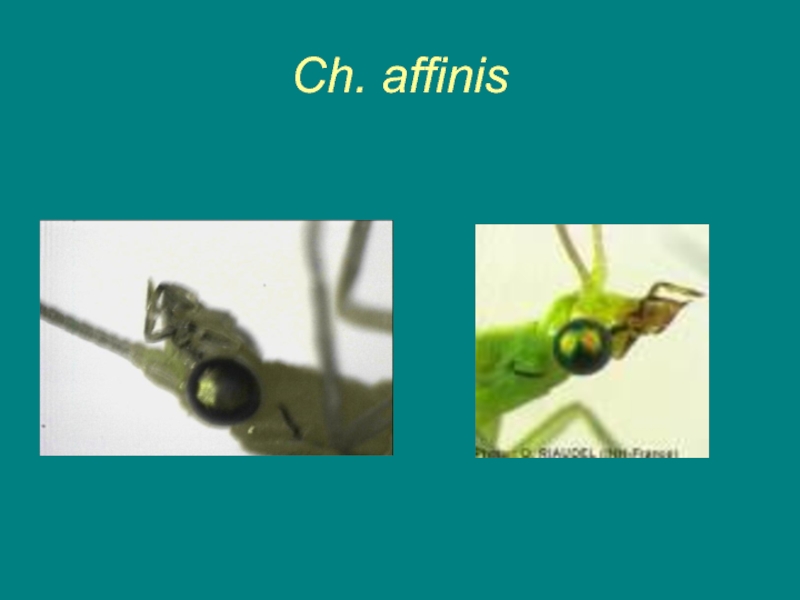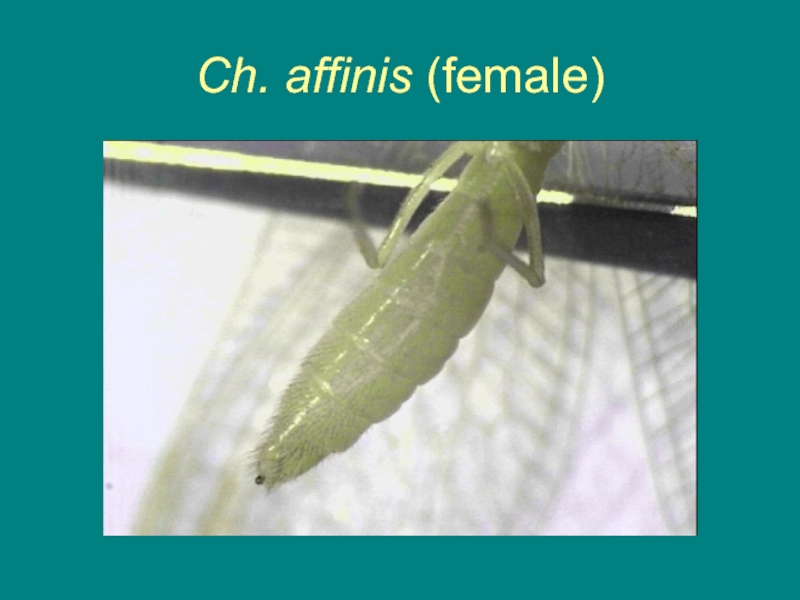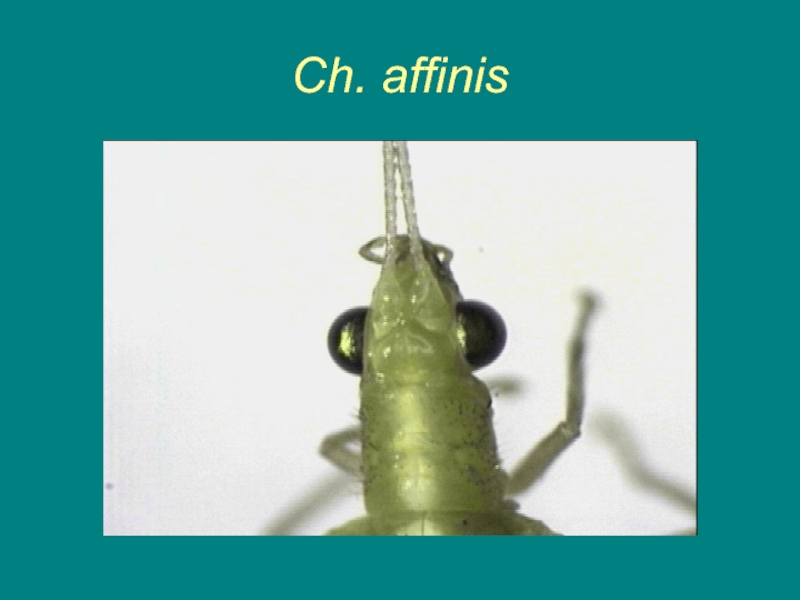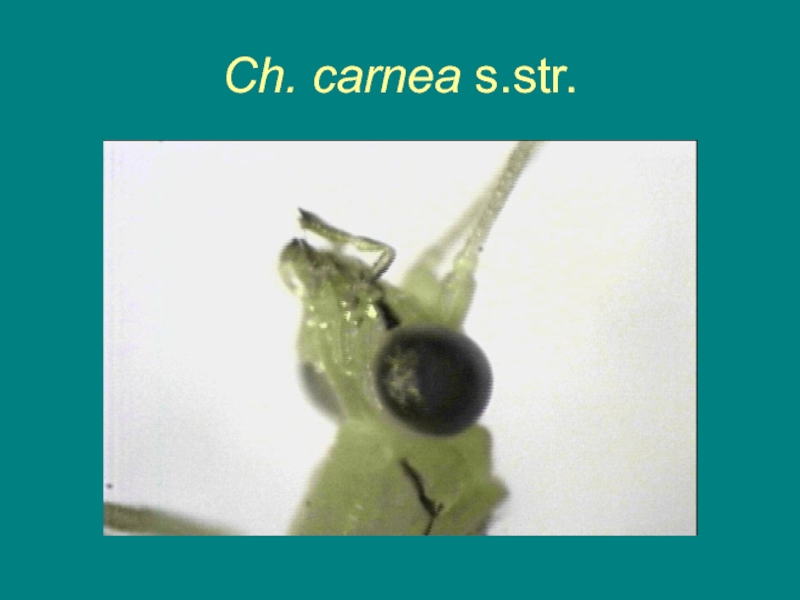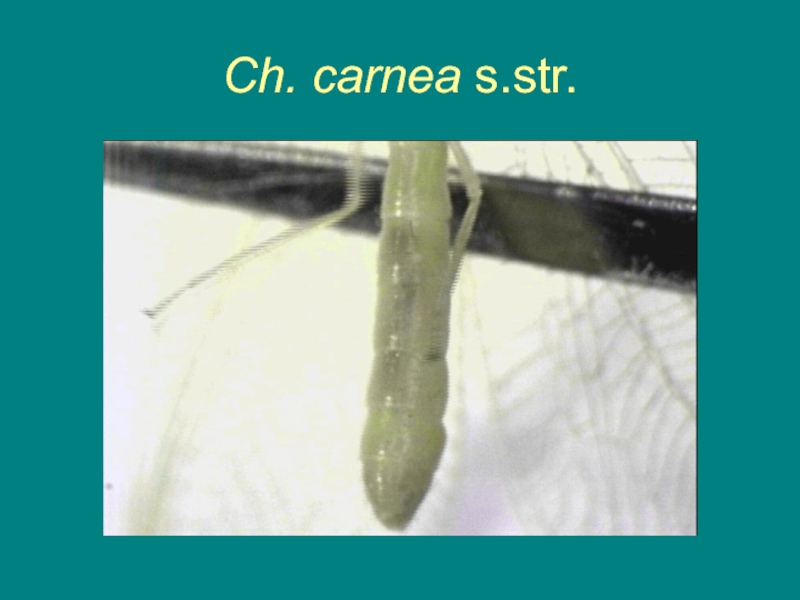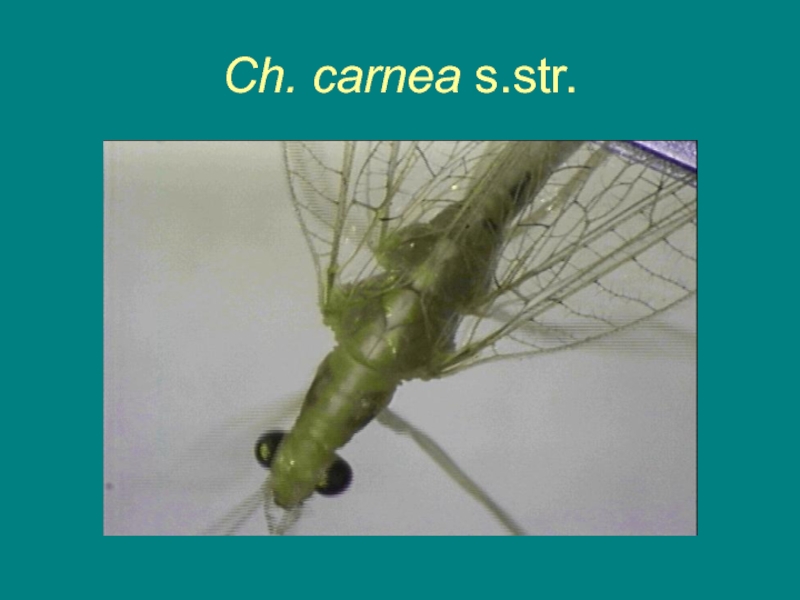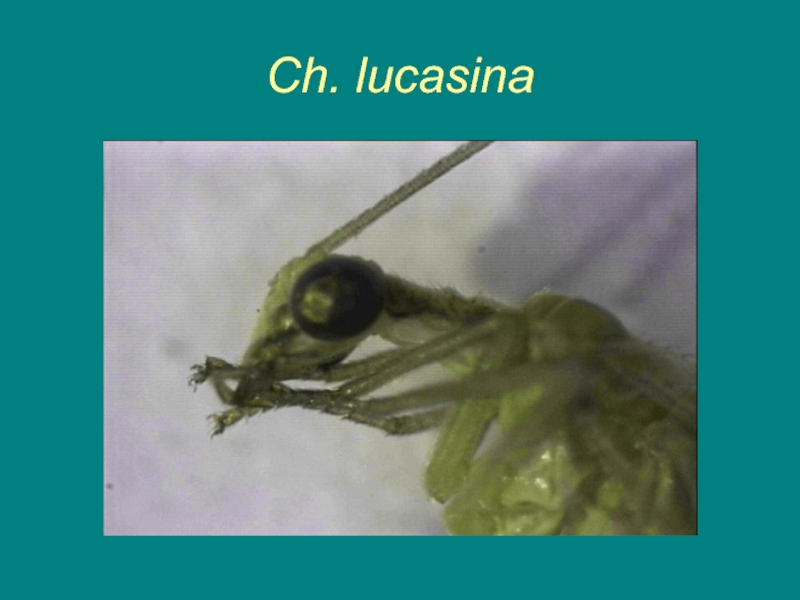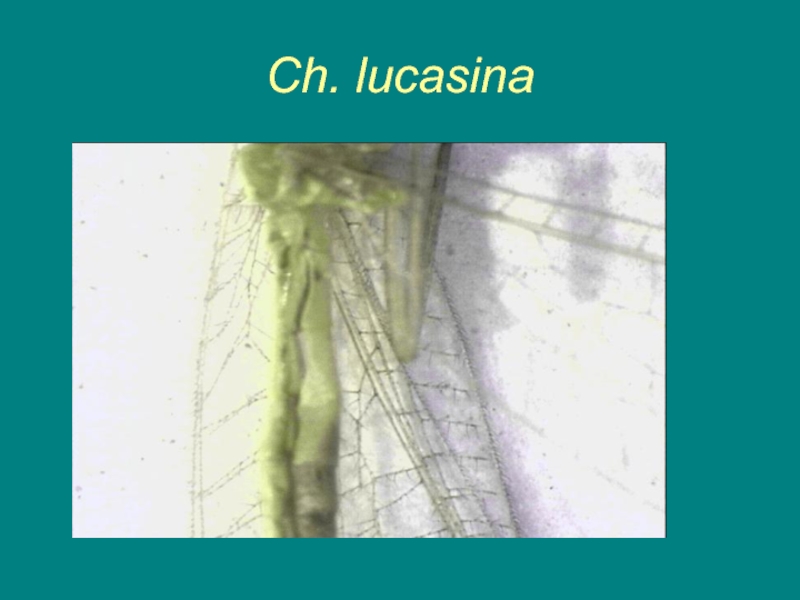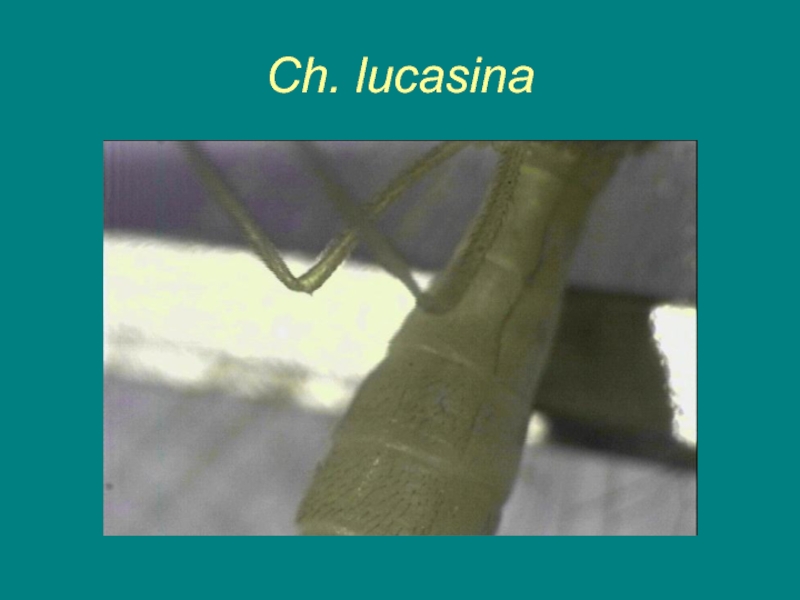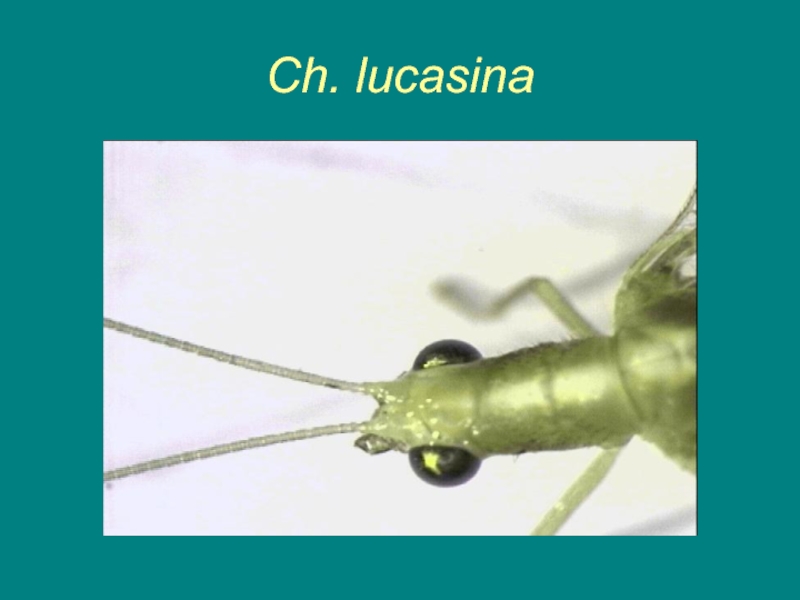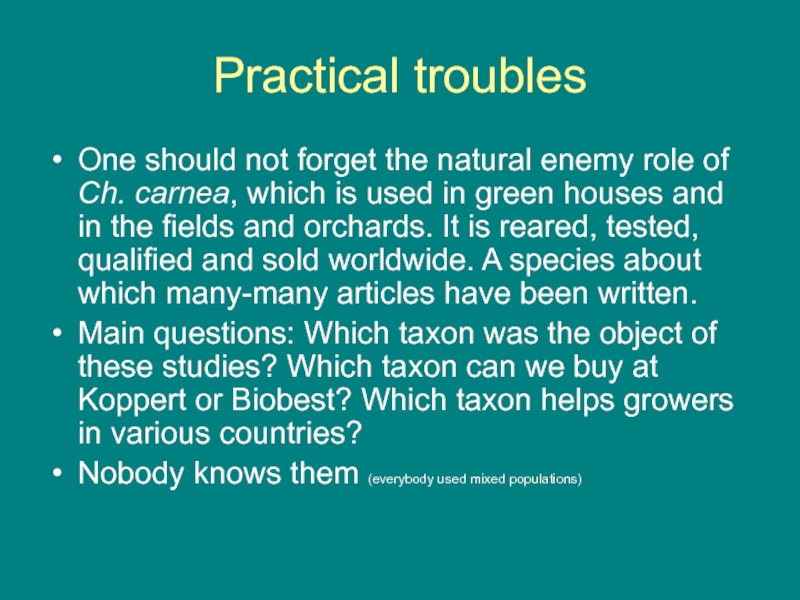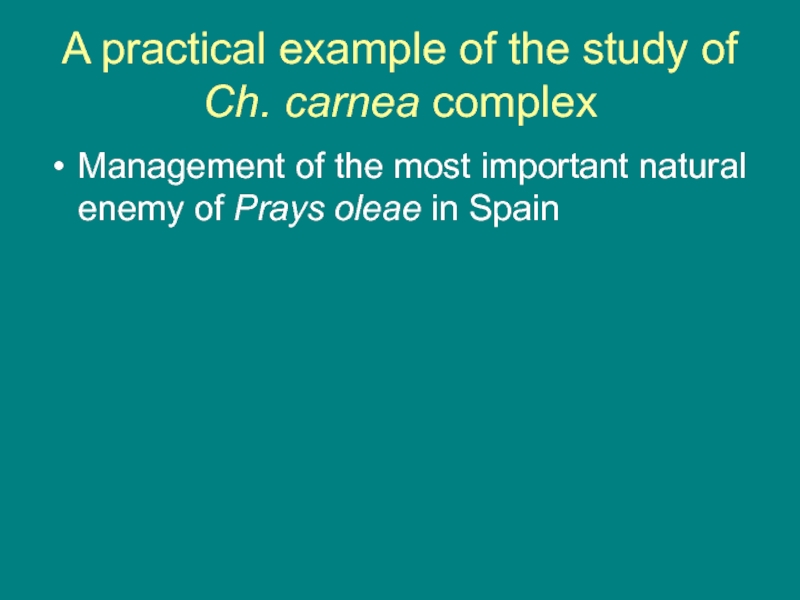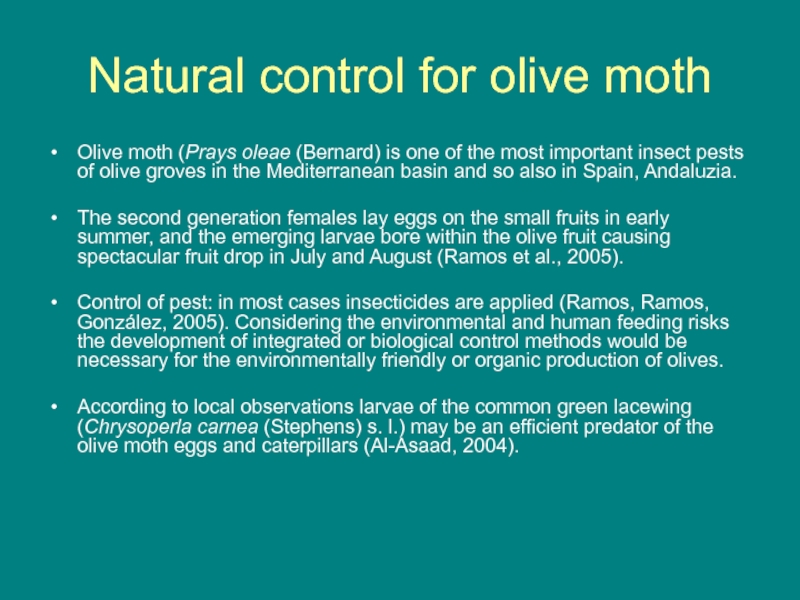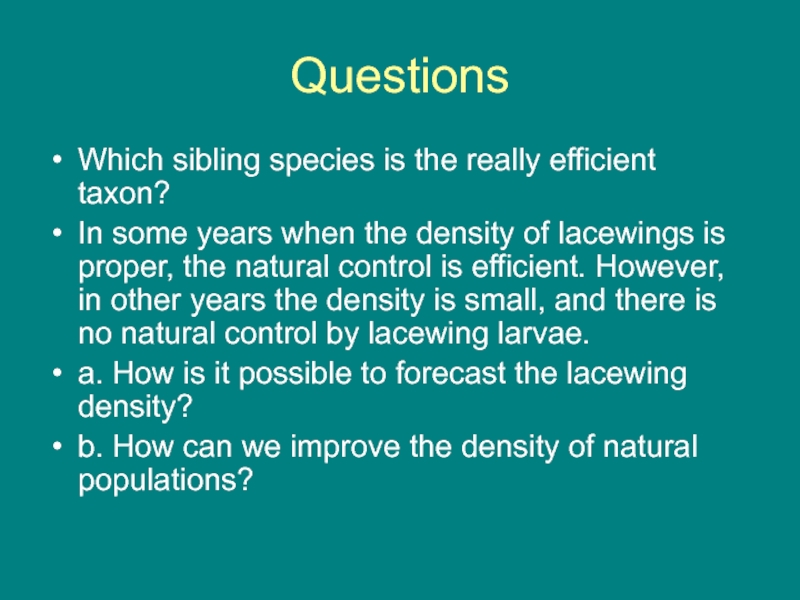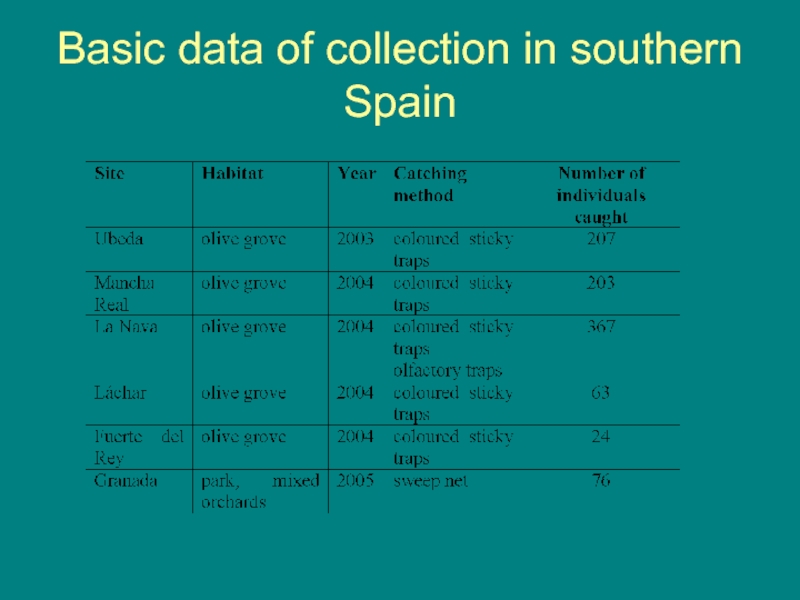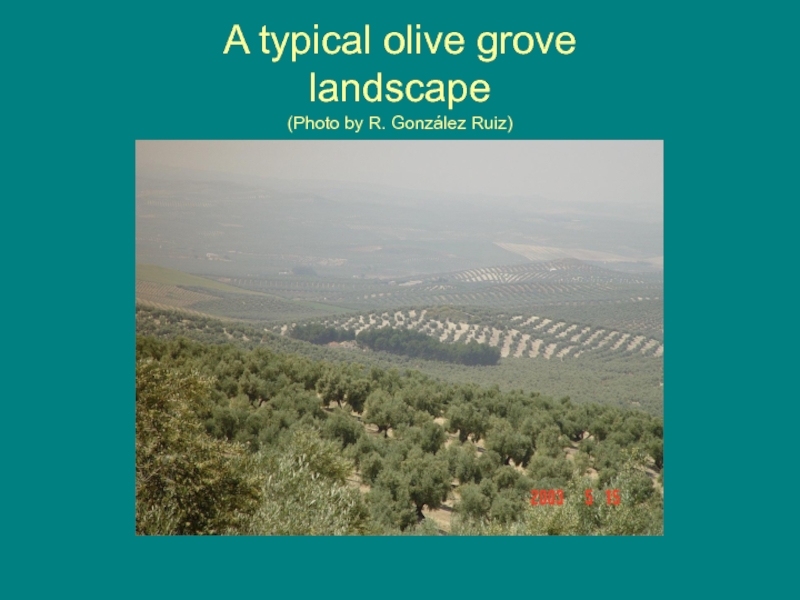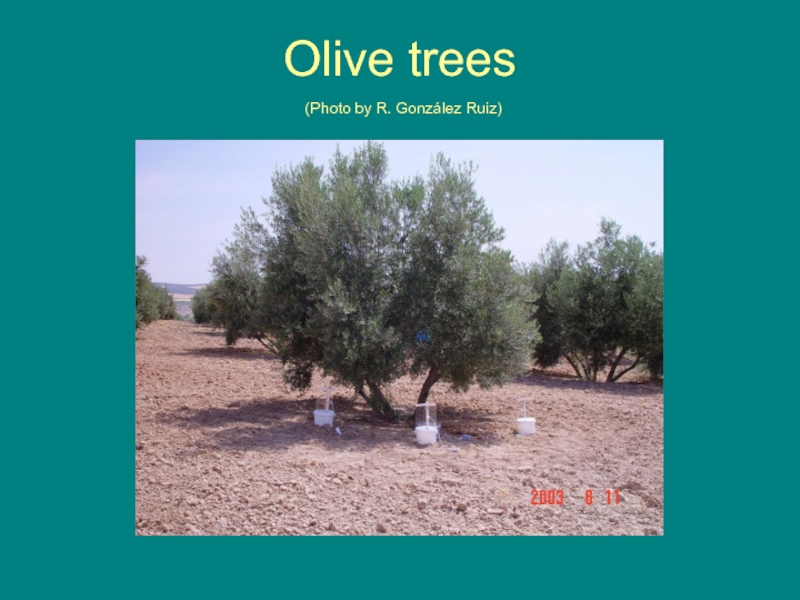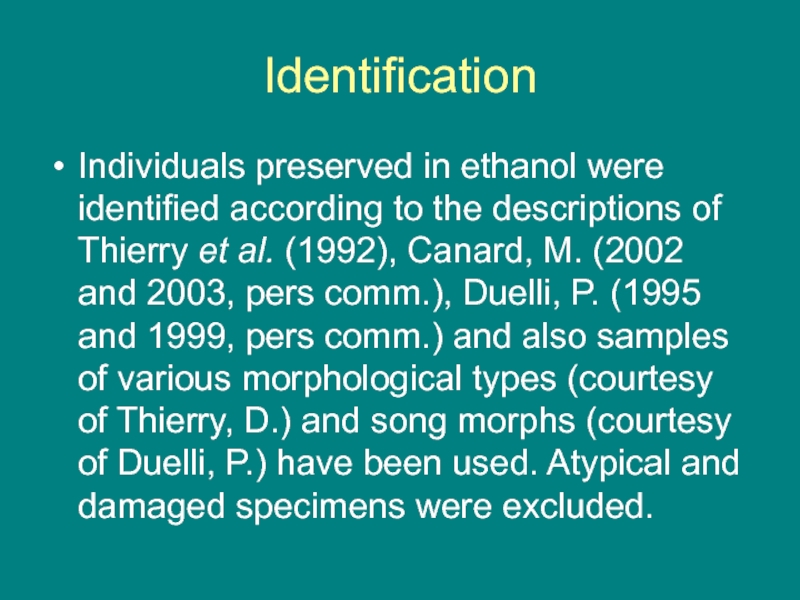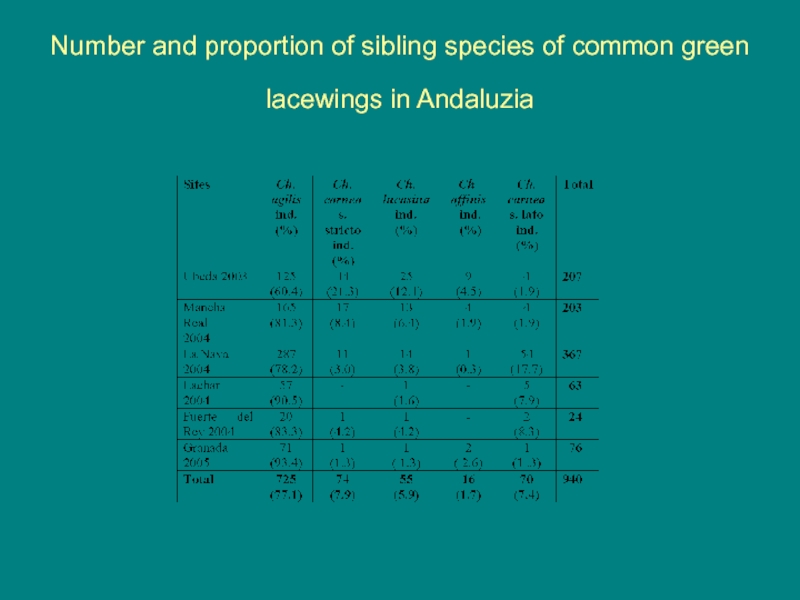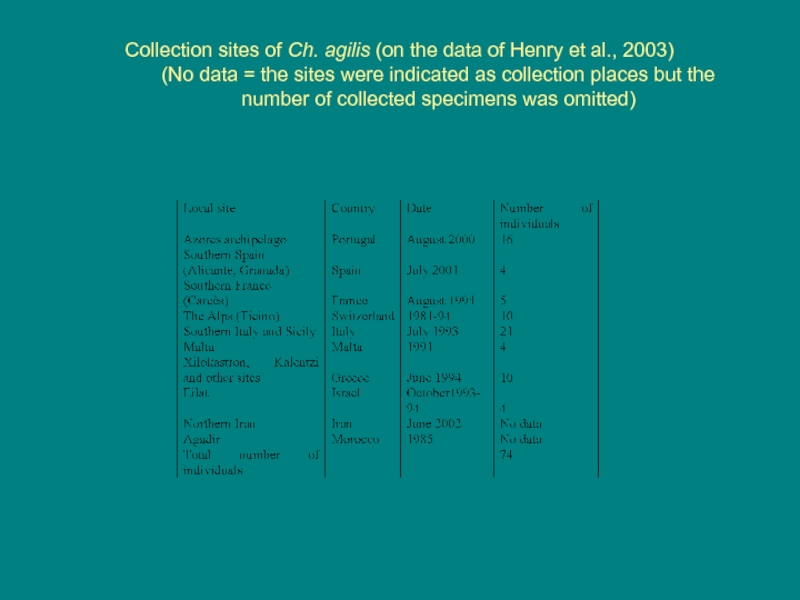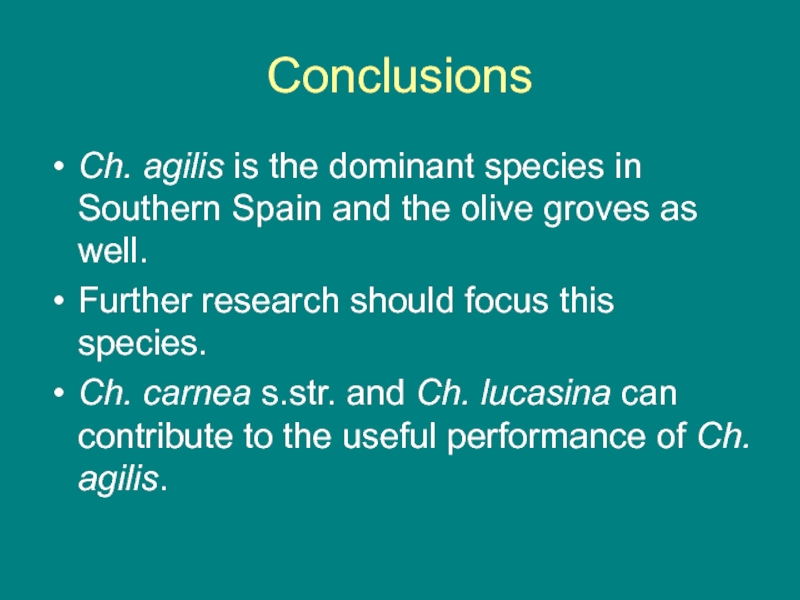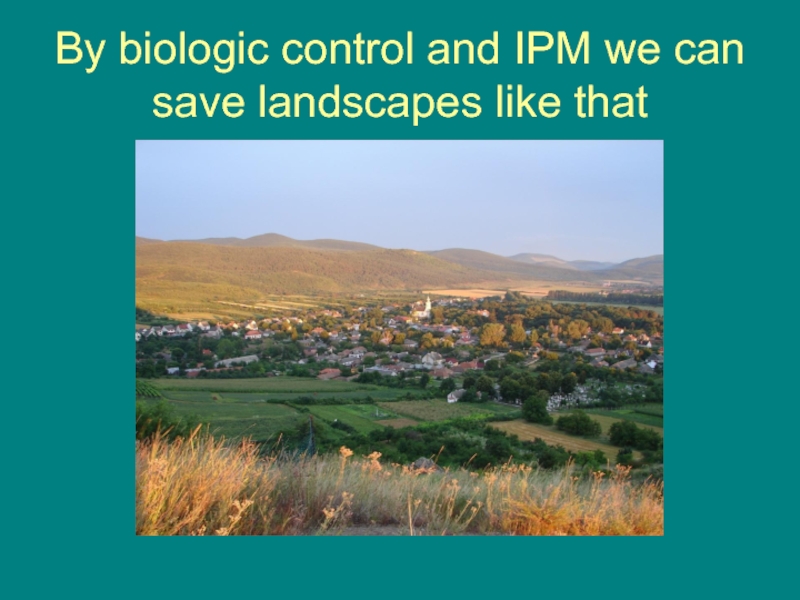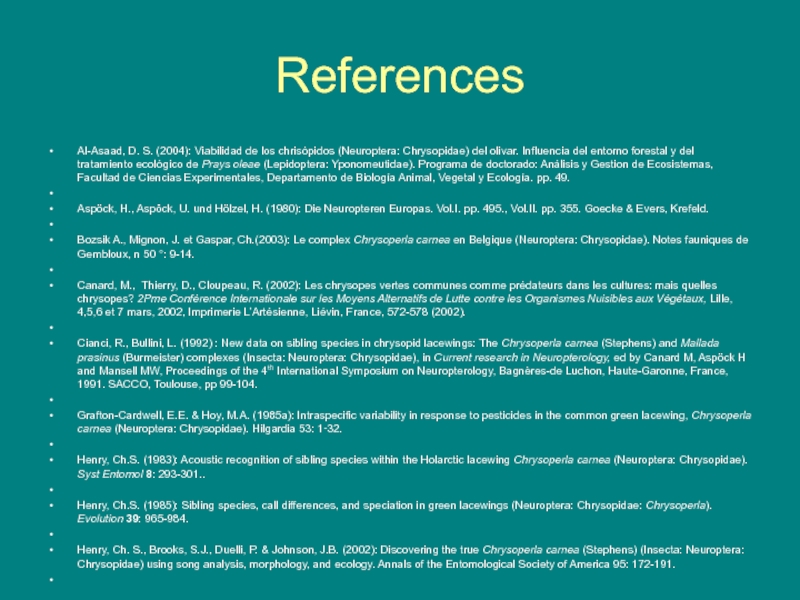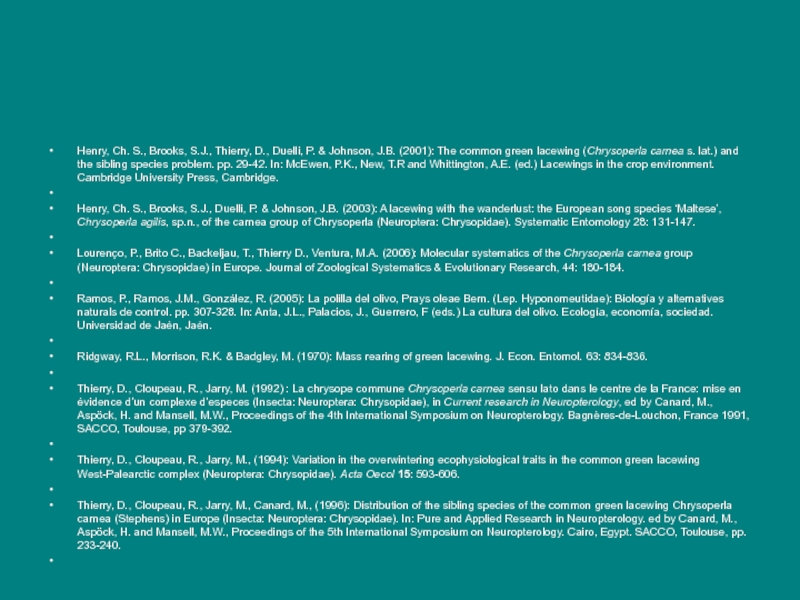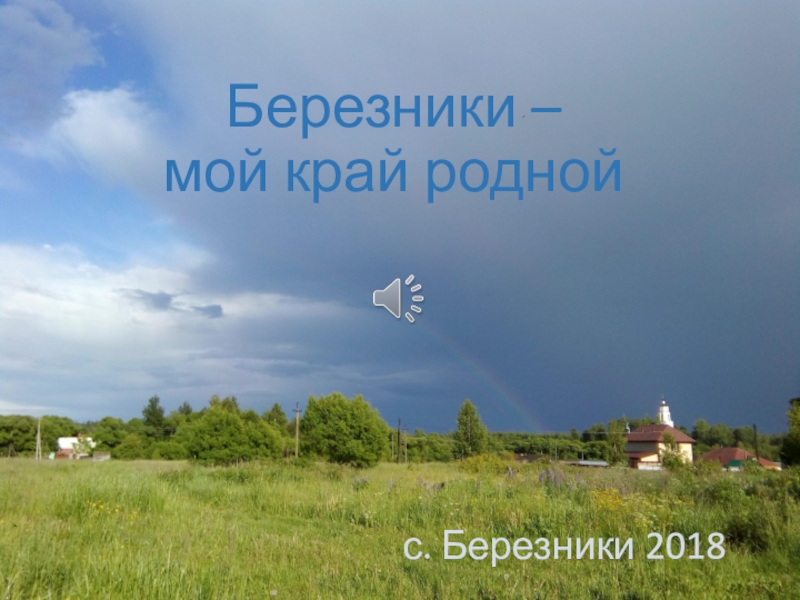Разделы презентаций
- Разное
- Английский язык
- Астрономия
- Алгебра
- Биология
- География
- Геометрия
- Детские презентации
- Информатика
- История
- Литература
- Математика
- Медицина
- Менеджмент
- Музыка
- МХК
- Немецкий язык
- ОБЖ
- Обществознание
- Окружающий мир
- Педагогика
- Русский язык
- Технология
- Физика
- Философия
- Химия
- Шаблоны, картинки для презентаций
- Экология
- Экономика
- Юриспруденция
Dataset 3. Lecture presented on the 4th International Plant Protection
Содержание
- 1. Dataset 3. Lecture presented on the 4th International Plant Protection
- 2. First data on the sibling species of
- 3. SummaryCommon green lacewings are good candidates for
- 4. The taxonomic status of the most important lacewing species in Andaluzia
- 5. Introduction Chrysopids and among them the common
- 6. Systematic troubles The original name of the
- 7. Attempts for clearing the taxonomic status of Chrysoperla carnea s.l.
- 8. Courtship sonification (Henry, 1994; Henry et al.,
- 9. Weak points of courtship sonificationnobody could verify
- 10. Genetic studies with multilocus electrophoresis and
- 11. Morphological characterization of adults (Thierry et al.,
- 12. Morphological characterization of adults (Henry et al.,
- 13. Ecological differences (Thierry et al., (1994), Henry
- 14. Ecophysiological variability Thierry et al. (1994)Overwintering placesCh.
- 15. AChE tolerance (Bozsik et al., 2002 unpublished)Variation
- 16. The different evidences supported the existence of
- 17. Oscillographs of some European Chrysoperla spp. Source:
- 18. Oscillograph of Ch. affinis (Cc4, motorboat)
- 19. Oscillograph of Ch. carnea s.str. (Cc2, slow-motorboat)
- 20. Oscillograph of Ch. lucasina
- 21. Oscillograph of Ch. agilis (Cc3, Maltese)
- 22. Morphology of Chrysoperla spp.
- 23. Ch. affinis
- 24. Ch. affinis (female)
- 25. Ch. affinis
- 26. Ch. carnea s.str.
- 27. Ch. carnea s.str.
- 28. Ch. carnea s.str.
- 29. Ch. lucasina
- 30. Ch. lucasina
- 31. Ch. lucasina
- 32. Ch. lucasina (female)
- 33. Ch. lucasina
- 34. Practical troubles One should not forget the
- 35. A practical example of the study of
- 36. Natural control for olive mothOlive moth (Prays
- 37. QuestionsWhich sibling species is the really efficient
- 38. Future tasksa. - identification of the
- 39. Basic data of collection in southern Spain
- 40. A typical olive grove landscape (Photo by R. González Ruiz)
- 41. Olive trees (Photo by R. González Ruiz)
- 42. IdentificationIndividuals preserved in ethanol were identified according
- 43. Number and proportion of sibling species of common green lacewings in Andaluzia
- 44. Collection sites of Ch. agilis (on the
- 45. ConclusionsCh. agilis is the dominant species in
- 46. By biologic control and IPM we can save landscapes like that
- 47. ReferencesAl-Asaad, D. S. (2004): Viabilidad de los
- 48. Henry, Ch. S., Brooks, S.J., Thierry, D.,
- 49. Thierry, D., Cloupeau, R., Jarry, M., Canard,
- 50. Скачать презентанцию
First data on the sibling species of the common green lacewings in Spain (Neuroptera: Chrysopidae) A. Bozsik and R. González RuízDepartment of Plant ProtectionUniversity of Debrecen, Hungary Department of Animal and
Слайды и текст этой презентации
Слайд 1Dataset 3. Lecture presented on the 4th International Plant Protection
Symposium at Debrecen University , Hungary, 18-19 October 2006
Слайд 2First data on the sibling species of the common green
lacewings in Spain (Neuroptera: Chrysopidae)
A. Bozsik and R. González
RuízDepartment of Plant Protection
University of Debrecen, Hungary
Department of Animal and Vegetal Biology and Ecology, University of Jaén, Spain
Слайд 3Summary
Common green lacewings are good candidates for use in IPM
programs because they are distributed worldwide, have a wide host
plant and prey range, can be easily mass cultured, manipulated using food sprays and overwintering boxes, and pesticide tolerant populations have been identified. Although a lot of work has been carried out on Chrysopidae, but regarding the many gaps in their natural history, green lacewings are little known insects, and even their taxonomic status – at least that of the most important taxon Chysoperla carnea (Stephens) – is uncertain. It is instead of a polymorphic single species, a complex of cryptic species, the Chrysoperla carnea complex or carnea-group. In present contribution composition of the natural Ch. carnea population was investigated in order to establish systematic bases for biological control studies in olive groves of Spain. Our results based on 940 lacewings, represents the biggest number of Ch. carnea complex specimens ever identified in Spain. Ch. agilis predominated with its 77% value. It was followed by Ch. carnea s.str. (8%), Ch. lucasina (6%), Ch affinis (2%). Regarding the number of captured specimens, it seems that Ch. agilis is the dominant species whose impact on olive moth caterpillars the greatest can be. The abundance and frequency of Ch. affinis was the smallest, and the other sibling species with their 6-8% frequency can have only more modest role in biological control of P. oleae.Слайд 5Introduction
Chrysopids and among them the common green lacewings are
not only attractive and wonderful insects but also good candidates
for IPM programs becausethey are distributed worldwide (Principi & Canard, 1984),
have a wide host plant and prey range (Principi & Canard, 1984),
can be mass cultured (Ridgway et al., 1980)
manipulated using food sprays (Hagen & Tassen, 1980),
overwintering chambers (McEwen et al., 1999)
pesticide tolerant populations have been identified (Grafton-Cardwell & Hoy, 1985).
However, there is something which can made uncertain all these data. This is the present taxnomic status of Chrysoperla carnea.
Слайд 6Systematic troubles
The original name of the species was Chrysopa
carnea. However, because of taxonomical accuracy (nervature and genitalia) Steinmann
(1964) created the genus Chrysoperla, and Chrysoperla carnea was long considered highly polymorphic, as reflected by the numbers of varieties, subspecies, e.g. 29 in Navás (1915), eight in Steinmann (1967), 16 in Aspöck et al. (1980), 14 in Brooks (1994) and 80 in Duelli (unpubl.).The taxonomic status of Ch. carnea has been changing, and instead of a polymorphic single species, a complex of sibling or cryptic species, the Chrysoperla carnea complex or carnea-group (Thierry et al., 1992; Thierry et al.,1998; Henry et al., 2001 ) should be now considered whose members` systematic status is not known enough (Tauber et al., 2000, Henry et al., 2001).
Слайд 8Courtship sonification (Henry, 1994; Henry et al., 2002)
Silent inaudible
sing: the male places himself in front of the female
and starts to oscillate his abdomen vertically at 30-120 Hz, shaking the substrate.The female with her extremely sensitive mechanoreceptors in the tibiae are tuned sharply to the frequency range characteristic of the species.
If the frequency sang by the male suits the frequency range characteristic of the species, the female answers, and they sing in duet and the copulation takes place.
In case of singing improper frequency, the female does not accept the male.
However, sibling species of the complex hybridize in the laboratory when given no choice. The progenies of these crossings are viable and fertile.
Слайд 9Weak points of courtship sonification
nobody could verify the method except
Henry and colleagues
the methodology is too complicated, unsuitable for identifying
a great number of individualsonly living insects can be used,
females and males should be maintained in the laboratory,
long observation period is needed under perfect conditions for the lacewings in order to be
ready for copulation,
tremulation should be recorded
influence of the recordings should be verified
Слайд 10Genetic studies with multilocus electrophoresis
and molecular systematics
Regarding multilocus
electrophoresis there are differences but variation is too considerable, because
Cianchi and Bullini (1992) unrecognized the sibling speciesRelationships among Eurasian species are ambiguous according to molecular systematic results (Henry et al., 1999)
Слайд 11Morphological characterization of adults (Thierry et al., 1992)
colour of ventral
setae on the distal portion of the abdomen: blond/light versus
black/browndark markings on the maxillary stipes: slight/point versus extensive/stripe
shape of the basal dilatation of the hind pretarsal claws: broad versus narrow
length of setae on the costal parts of fore wings: short versus long
colour of dorsal setae on the pronotum: blond/light versus black/brown
dark brown stripe on the pleural membrane of the second abdominal segment
colour of genae: green versus reddish
manifestation of overwintering coloration: green versus reddish/yellowish
Weak points:
considerable variation in case of some characteristics
Слайд 12Morphological characterization of adults (Henry et al., 2002)
fine structure
of the male distal abdomen
Weak points:
only males can be
identifieddry or pinned material can be determined with difficulty if possible
the implementation of the method is too slow
nobody used it for identification of many lacewings
Слайд 13Ecological differences (Thierry et al., (1994), Henry et al., (2002)
Ch.
carnea is an arboreal species
Ch. affinis prefers croplands and meadows
Ch.
lucasina prefers croplands, too Слайд 14Ecophysiological variability Thierry et al. (1994)
Overwintering places
Ch. carnea hibernates in
rolled dry leaves and in ivy tufts
Ch. affinis hibernates indoors
(in buildings)Ch. lucasina overwinters in ivy tufts
Recovery of vitellogenesis
Two week delay in recovery of reproductive activity between Ch. carnea and Ch. affinis
Слайд 15AChE tolerance (Bozsik et al., 2002 unpublished)
Variation in tolerance level
can be important.
Further work is needed.
Слайд 16The different evidences supported the existence of various cryptic species
Ch. carnea former Chrysoperla kolthoffi (Navás, 1927) sensu Cloupeau (Cc4
as song species), or “motorboat”(as song type) (Henry et al., 2002) or Ch. affinis Stephens, 1836 former Ch. kolthoffi (Thierry et al., 1998)Chrysoperla carnea sensu stricto (Thierry et al., 1998) or Cc2 (“slow-motorboat”) or Chrysoperla pallida sp. nov. (Henry et al., 2002).
Chrysoperla lucasina (Lacroix, 1912) (Henry et al., 2001)
Chrysoperla agilis sp. nov. (Henry et al., 2003) or Cc3 (Maltese)
Слайд 17Oscillographs of some European Chrysoperla spp.
Source:
http://www.eeb.uconn.edu/people/chenry/Cryptic_songs.html
The Cryptic Song
Species of Chrysoperla
Charles S. Henry, Department of Ecology & Evolutionary
Biology, University of ConnecticutСлайд 34Practical troubles
One should not forget the natural enemy role
of Ch. carnea, which is used in green houses and
in the fields and orchards. It is reared, tested, qualified and sold worldwide. A species about which many-many articles have been written.Main questions: Which taxon was the object of these studies? Which taxon can we buy at Koppert or Biobest? Which taxon helps growers in various countries?
Nobody knows them (everybody used mixed populations)
Слайд 35A practical example of the study of Ch. carnea complex
Management
of the most important natural enemy of Prays oleae in
SpainСлайд 36Natural control for olive moth
Olive moth (Prays oleae (Bernard) is
one of the most important insect pests of olive groves
in the Mediterranean basin and so also in Spain, Andaluzia.The second generation females lay eggs on the small fruits in early summer, and the emerging larvae bore within the olive fruit causing spectacular fruit drop in July and August (Ramos et al., 2005).
Control of pest: in most cases insecticides are applied (Ramos, Ramos, González, 2005). Considering the environmental and human feeding risks the development of integrated or biological control methods would be necessary for the environmentally friendly or organic production of olives.
According to local observations larvae of the common green lacewing (Chrysoperla carnea (Stephens) s. l.) may be an efficient predator of the olive moth eggs and caterpillars (Al-Asaad, 2004).
Слайд 37Questions
Which sibling species is the really efficient taxon?
In some
years when the density of lacewings is proper, the natural
control is efficient. However, in other years the density is small, and there is no natural control by lacewing larvae.a. How is it possible to forecast the lacewing density?
b. How can we improve the density of natural populations?
Слайд 38Future tasks
a.
- identification of the lacewing species (sibling
species) controlling olive moth caterpillars,
- measuring the predatory performance of lacewing larvae using in situ observation and laboratory experiments, b.
- study of population dynamics of lacewings and its dependence on major environmental factors
- measuring the efficiency of food sprays and over-wintering boxes for possible augmentation and conservation of common green lacewing adults.
- studying the impact of uncultivated areas for natural lacewing populations, mainly for their maintenance, overwintering and distribution.
Слайд 42Identification
Individuals preserved in ethanol were identified according to the descriptions
of Thierry et al. (1992), Canard, M. (2002 and 2003,
pers comm.), Duelli, P. (1995 and 1999, pers comm.) and also samples of various morphological types (courtesy of Thierry, D.) and song morphs (courtesy of Duelli, P.) have been used. Atypical and damaged specimens were excluded.Слайд 44Collection sites of Ch. agilis (on the data of Henry
et al., 2003) (No
data = the sites were indicated as collection places but the number of collected specimens was omitted)Слайд 45Conclusions
Ch. agilis is the dominant species in Southern Spain and
the olive groves as well.
Further research should focus this species.
Ch.
carnea s.str. and Ch. lucasina can contribute to the useful performance of Ch. agilis.Слайд 47References
Al-Asaad, D. S. (2004): Viabilidad de los chrisópidos (Neuroptera: Chrysopidae)
del olivar. Influencia del entorno forestal y del tratamiento ecológico
de Prays oleae (Lepidoptera: Yponomeutidae). Programa de doctorado: Análisis y Gestion de Ecosistemas, Facultad de Ciencias Experimentales, Departamento de Biología Animal, Vegetal y Ecología. pp. 49.Aspöck, H., Aspöck, U. und Hölzel, H. (1980): Die Neuropteren Europas. Vol.I. pp. 495., Vol.II. pp. 355. Goecke & Evers, Krefeld.
Bozsik A., Mignon, J. et Gaspar, Ch.(2003): Le complex Chrysoperla carnea en Belgique (Neuroptera: Chrysopidae). Notes fauniques de Gembloux, n 50 °: 9-14.
Canard, M., Thierry, D., Cloupeau, R. (2002): Les chrysopes vertes communes comme prédateurs dans les cultures: mais quelles chrysopes? 2Pme Conférence Internationale sur les Moyens Alternatifs de Lutte contre les Organismes Nuisibles aux Végétaux, Lille, 4,5,6 et 7 mars, 2002, Imprimerie L’Artésienne, Liévin, France, 572-578 (2002).
Cianci, R., Bullini, L. (1992) : New data on sibling species in chrysopid lacewings: The Chrysoperla carnea (Stephens) and Mallada prasinus (Burmeister) complexes (Insecta: Neuroptera: Chrysopidae), in Current research in Neuropterology, ed by Canard M, Aspöck H and Mansell MW, Proceedings of the 4th International Symposium on Neuropterology, Bagnères-de Luchon, Haute-Garonne, France, 1991. SACCO, Toulouse, pp 99-104.
Grafton-Cardwell, E.E. & Hoy, M.A. (1985a): Intraspecific variability in response to pesticides in the common green lacewing, Chrysoperla carnea (Neuroptera: Chrysopidae). Hilgardia 53: 1‑32.
Henry, Ch.S. (1983): Acoustic recognition of sibling species within the Holarctic lacewing Chrysoperla carnea (Neuroptera: Chrysopidae). Syst Entomol 8: 293-301..
Henry, Ch.S. (1985): Sibling species, call differences, and speciation in green lacewings (Neuroptera: Chrysopidae: Chrysoperla). Evolution 39: 965-984.
Henry, Ch. S., Brooks, S.J., Duelli, P. & Johnson, J.B. (2002): Discovering the true Chrysoperla carnea (Stephens) (Insecta: Neuroptera: Chrysopidae) using song analysis, morphology, and ecology. Annals of the Entomological Society of America 95: 172-191.
Слайд 48Henry, Ch. S., Brooks, S.J., Thierry, D., Duelli, P. &
Johnson, J.B. (2001): The common green lacewing (Chrysoperla carnea s.
lat.) and the sibling species problem. pp. 29-42. In: McEwen, P.K., New, T.R and Whittington, A.E. (ed.) Lacewings in the crop environment. Cambridge University Press, Cambridge.Henry, Ch. S., Brooks, S.J., Duelli, P. & Johnson, J.B. (2003): A lacewing with the wanderlust: the European song species ‘Maltese’, Chrysoperla agilis, sp.n., of the carnea group of Chrysoperla (Neuroptera: Chrysopidae). Systematic Entomology 28: 131-147.
Lourenço, P., Brito C., Backeljau, T., Thierry D., Ventura, M.A. (2006): Molecular systematics of the Chrysoperla carnea group (Neuroptera: Chrysopidae) in Europe. Journal of Zoological Systematics & Evolutionary Research, 44: 180-184.
Ramos, P., Ramos, J.M., González, R. (2005): La polilla del olivo, Prays oleae Bern. (Lep. Hyponomeutidae): Biología y alternatives naturals de control. pp. 307-328. In: Anta, J.L., Palacios, J., Guerrero, F (eds.) La cultura del olivo. Ecología, economía, sociedad. Universidad de Jaén, Jaén.
Ridgway, R.L., Morrison, R.K. & Badgley, M. (1970): Mass rearing of green lacewing. J. Econ. Entomol. 63: 834-836.
Thierry, D., Cloupeau, R., Jarry, M. (1992) : La chrysope commune Chrysoperla carnea sensu lato dans le centre de la France: mise en évidence d’un complexe d’especes (Insecta: Neuroptera: Chrysopidae), in Current research in Neuropterology, ed by Canard, M., Aspöck, H. and Mansell, M.W., Proceedings of the 4th International Symposium on Neuropterology. Bagnères-de-Louchon, France 1991, SACCO, Toulouse, pp 379-392.
Thierry, D., Cloupeau, R., Jarry, M., (1994): Variation in the overwintering ecophysiological traits in the common green lacewing West-Palearctic complex (Neuroptera: Chrysopidae). Acta Oecol 15: 593-606.
Thierry, D., Cloupeau, R., Jarry, M., Canard, M., (1996): Distribution of the sibling species of the common green lacewing Chrysoperla carnea (Stephens) in Europe (Insecta: Neuroptera: Chrysopidae). In: Pure and Applied Research in Neuropterology. ed by Canard, M., Aspöck, H. and Mansell, M.W., Proceedings of the 5th International Symposium on Neuropterology. Cairo, Egypt. SACCO, Toulouse, pp. 233-240.
Слайд 49Thierry, D., Cloupeau, R., Jarry, M., Canard, M. (1998): Discrimination
of the West-Palearctic Chrysoperla Steinmann species of the carnea Stephens
group by means of claw morphology (Neuroptera, Chrysopidae). Acta Zool Fennica 209: 255-262 (1998).Tauber, M.J, Tauber, C.A.,. Danee, K.M. & Hagen, S.K. (2000): Commercialization of predators: Recent lessons from green lacewings (Neuroptera: Chrysopidae: Chrysoperla). American Entomologist 46: 26-37.
